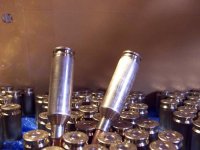V
VT52
Guest
Maybe interesting for some folks, old news for others... Someone at the club asked why people weigh brass and I looked up some figures to try to explain a little about the sense, or non-sense, for doing this (not just for BR, for plane-jane rec shooters as well).
Brass = 8400 kg/m3
Air = 1.29 kg/m3
Vihta N133 = 870 kg/m3
1 grain of brass displaces 1.29/8400 = 0.000153 grains of air
1 grain of brass displaces 870/8400 = 0.965 grains of powder
1 kernel of N133 weighs around 0.025grs
So 1 grain in case weight gives the same result as 0.1gr of powder (in terms of volume, not weight), ie 3-4 kernels of N133.
Depending on what you shoot (BR, plinking, high-power), that 0.1gr powder volume difference may mean nothing, or it may mean something. I can not, however (imho), see how sorting at the 0.1gr level of brass weight would mean anything, besides on paper, to real world results, as this would mean 0.01gr less volume for the powder.
Brass = 8400 kg/m3
Air = 1.29 kg/m3
Vihta N133 = 870 kg/m3
1 grain of brass displaces 1.29/8400 = 0.000153 grains of air
1 grain of brass displaces 870/8400 = 0.965 grains of powder
1 kernel of N133 weighs around 0.025grs
So 1 grain in case weight gives the same result as 0.1gr of powder (in terms of volume, not weight), ie 3-4 kernels of N133.
Depending on what you shoot (BR, plinking, high-power), that 0.1gr powder volume difference may mean nothing, or it may mean something. I can not, however (imho), see how sorting at the 0.1gr level of brass weight would mean anything, besides on paper, to real world results, as this would mean 0.01gr less volume for the powder.



